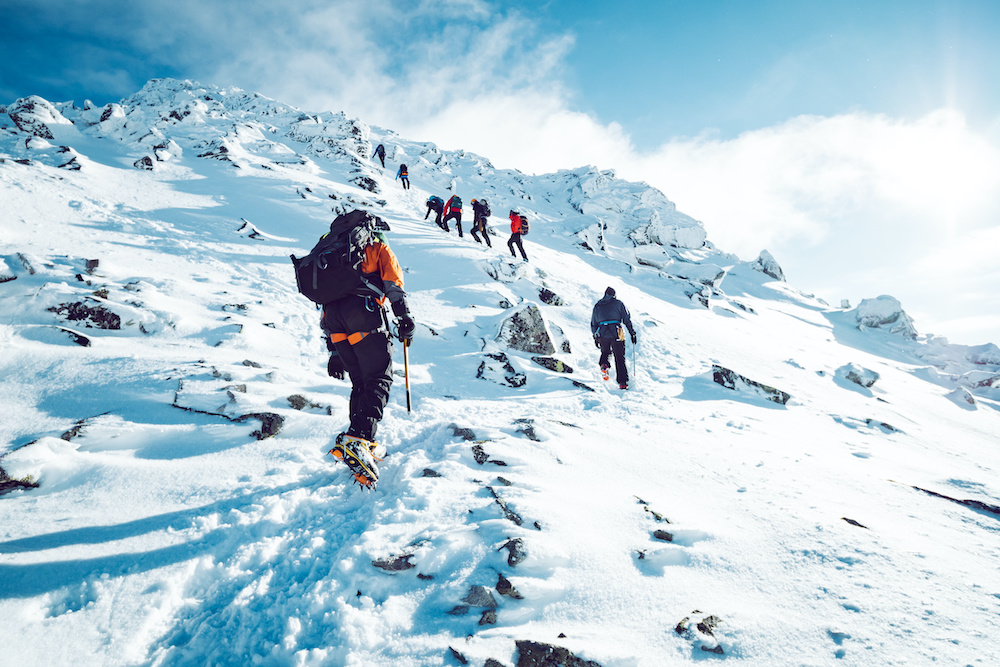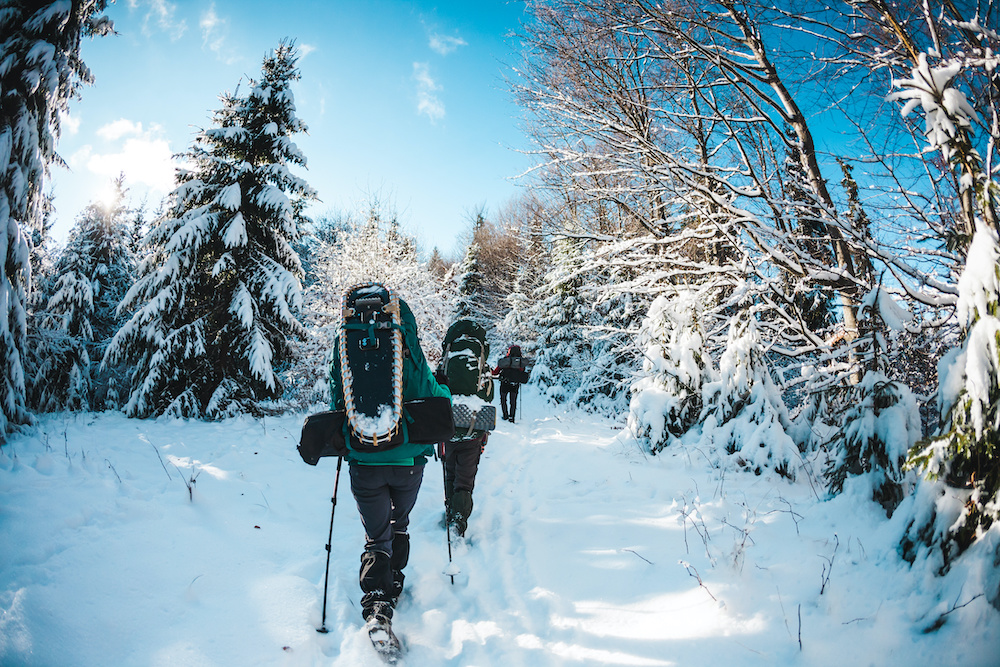
Some hikers shy away from exploring terrains during the winter due to the cold weather.
However, as long as you're prepared to tackle the harsh winter conditions, winter hiking can be a lot of fun!
If you're planning a hiking adventure for the winters or need a little help preparing for your trip, our winter hiking tips will prove to be useful.
Not only will we assist you in selecting the proper snow hiking footwear and gear, but we'll also help you prepare for emergencies.
What temperature is ideal for hiking in the snow or winter? And what other things should you consider before you set out on your adventure in winter?
Those are only a few of the questions we'll answer today, so let's get started!
What to Wear Hiking in the Winter
If your body isn't prepared to tackle the winter environment, your hiking trip will be a risk to your safety.
When preparing clothes for your snow hike, keep in mind that you'll only be comfortable if your clothes remain warm and dry.
Tops
Generally, we suggest you avoid cotton because it tends to hold moisture. If your clothes are wet, not only will you feel uncomfortable but you'll also get a cold.
We suggest sticking to synthetic fibers or wool, and to stay warm, make sure you have at least three layers of clothes.
You can select a woolen or synthetic shirt for the base layer, while a fleece can be a good option for the middle layer. You can top it all off with a waterproof jacket for the shell layer.
We recommend keeping an extra gilet in case you need extra warmth. If you feel hot, you can always take off a layer.
While it's crucial to stay warm, it might help if you start your hike with a few layers and put additional layers when you stop during breaks.
Bottoms
The layering on your bottoms is dependent on the weather conditions.
If it's not too cold, you can get away with a base layer of synthetic trousers and a waterproof shell on top.
On the other hand, if you're hiking in sub-zero temperatures, you can wear ski pants with your base layer and fleece leggings.
Gloves, Socks, and Hats
When hiking during the winter season, especially in sub-zero temperatures, frostbite is a huge danger. Therefore, it's important to keep your fingers and toes warm.
To keep your fingers warm, we suggest keeping two pairs of gloves: a warm base layer with a waterproof shell layer.
Ski-gloves are a great option if you want a waterproof layer and to maximize insulation.
Don't add too many layers on your hands that they become difficult to move your fingers or hold onto things.
For your socks, make sure the material it's made of doesn't absorb moisture. You don't want to catch a cold because of wet feet.
Lastly, you can prevent heat loss by covering up your head. Even if you feel like you can manage without a hat, we suggest keeping one in your bag just in case you might need it later.
Footwear
Hiking during the winter season is different than hiking in the summers. Your lightweight hiking boots are useless against the harsh winter environment.
You need proper footwear that will help conquer the winter terrain. We suggest you look into waterproof insulated winter boots that will help keep your toes warm.
If you're hiking through heaps of snow, it would be useful to invest in a pair of waterproof gaiters.
They will help prevent snow from getting inside your boots, keeping your feet warm and dry.
When hiking in the snow, you need a pair of footwear that is not only waterproof but will also prevent you from losing your balance.
There are three types of footwear you can look at for your snow hike:
- Microspikes
If you're on a limited budget and plan on trekking through flat grounds, then you might want to get microspikes.
Microspikes have tiny chains and spikes that can protect your feet on top of your boots.
The spikes dig into the snow as you walk, giving you more balance as you walk on snow or ice.
- Crampons
Crampons are a level up from the microspikes. Not only are they more durable, but they also have bigger spikes that give you more grip.
You can easily attach them to your hiking boots to help you tackle steep, slippery slopes.
Keep in mind that crampons add a significant amount of weight to your shoes and could be uncomfortable for some people.
- Snowshoes
If you're hiking through steep snow, then snowshoes are an excellent option to consider.
Snowshoes have a broad frame, giving you more surface area, improving your balance as you walk through slippery terrains.
These are relatively light and allow you to walk without quickly sinking in too deep snow.

What Do Hikers Do in the Winter to Hike Successfully?
Other than warm clothes, these are some winter hiking tips that most hikers follow:
Learn How to Walk in the Snow
Before you decide to explore a snowy terrain, you should become accustomed to walking in the snow.
When you're walking uphill on snow, it's best to take small steps while kicking into the layer of snow.
If you're going downhill, we suggest you learn plunge stepping, wherein you use gravity to help you descend the hill or slope.
You set your heel into the snow and then let gravity pull you down. Don't jump or drop, and don't lock your leg, as you might end up injuring your knee if you do.
Go Uphill
When hiking in the winter, it's a good idea to pick an uphill trail. Going uphill requires more energy, which makes your heart pump blood faster.
Think about how your heart pumps faster and your cheeks flush when you climb a large flight of stairs. It's similar when you go uphill.
Your heart beats faster, increasing circulation in your body, resulting in more heat production.
If you do pick an uphill trail, keep in mind that you might sweat a lot. So, make sure your clothes and footwear are moisture-wicking.
Hike While the Sun Is Out
Unlike summer hiking, when hiking in the winter, it's better to hike while the sun is out and rest when it sets.
You want to take as much warmth from the sun as you can. You can also enjoy the scenic view better when the sun is out while hiking.
Once the sun drops, not only will you lose the light, but you'll also lose the warmth as the temperature drops. The wind also becomes more chilly as night falls.
Stay Hydrated
When hiking in the winter, people usually forget to stay hydrated. You shouldn't make this mistake.
Keep a bottle of water with you and stay hydrated as you trek the snowy terrain.
Also, make sure your water is insulated. You don't want it to freeze due to the low temperature.
Another way of staying hydrated and warm is by keeping a flask of hot beverages.
You can keep hot chocolate, tea, coffee, or even soup broth in your flask. Whenever you feel cold, you can take a sip to warm your body up.
We suggest you stay away from beverages that contain alcohol since it lowers your body temperature.
Keep Snacks
As you hike, your body uses up energy and burns calories, so it's a good idea to pack snacks to help you maintain energy.
We suggest keeping snacks that have proteins and carbs. Protein and energy bars are a good idea for a quick burst of energy.
Keep on Moving
If you stop too often for too long, you'll begin to feel cold. It would help if you kept moving to keep your body warm.
How Do You Prepare for Winter Hiking?
Apart from preparing the proper set of clothes and other essentials, here are a few things you need to know before you head out on your winter adventure.
Here are some of the ways you can prepare yourself:
Weather
When you're planning for a snow hiking trip, one of the first things you need to look at is weather conditions.
Only once you're aware of the weather conditions can you prepare the correct clothing and gear.
In addition, you need to start monitoring the weather a week before your trip, so you know what's waiting for you during your hike.
Also, if the weather seems too dangerous, don't hesitate to turn back.
How Cold Is Too Cold for Hiking?
When is it too cold to hike in the winter? As we mentioned earlier, as long as you're prepared for the cold, you can hike at any temperature.
If it's your first time hiking in the winter, we suggest you start easy.
Aim for a temperature between 20F and 50F. This way, you won't need a lot of layers; just two will be sufficient.
If you do have some experience trekking in the winter and want to aim for a temperature lower than 20F, then we suggest you have at least three layers on top.
You may want to add layers of clothes for temperatures below 0F.
Gear
Your hiking experience can completely change depending on the type of gear you pack with you.
When selecting a backpack, make sure it is durable, lightweight, and has enough storage space for you to pack all your essentials.
Your tent and sleeping bag needs to be durable and waterproof. It should also be able to keep you warm in the harsh cold.
We also suggest keeping a walking pole or an ice ax to give yourself some additional support as you hike.
Learning how to use an ice ax properly will be very beneficial, making it easier when ascending or descending slopes.
Safety
Safety should be your top priority when preparing for your winter hiking trip. Make sure at least one person in your hiking group has kept a first aid kit.
You need to be aware of the risks of Avalanche. Make sure you understand at least the basics of avalanches so you can avoid high-risk areas.
Generally, there are two types of avalanches:
- Loose-Snow
These can happen in both wet or dry snow. It starts near the surface and gathers more snow as it falls.
- Slab
This is more dangerous and happens when an entire shelf of snow falls and slides down a mountain.
It's better if you familiarize yourself with your trail beforehand. Talk to some people who know the terrain so you can avoid high-risk areas.
Another important thing to learn is some necessary information about hypothermia, a condition where your body temperature drops, impairing muscular and cerebral functions.
Here are some conditions that may lead to hypothermia:
- Low temperature
- Wetness
- Exhaustion or Dehydration
- Loss of heat in the body
If you see your companions showing any of these symptoms, we suggest you head back or seek help immediately:
- Violent shivering or shaking
- Lethargy
- Inability to speak or move limbs
Communication
Regardless of whether you go hiking in the winter or summer, you need to ensure that people know where you're going.
The night before your hiking trip, make sure you recharged the batteries of all your devices. We suggest you keep backup power as well.
Likewise, make sure you and the people joining your hike know the rescue team's contact number.
We also suggest you keep flashlights and whistles as other means to draw attention in emergencies. Also, keep maps and a compass in case you get lost.
Winter Hiking Tips for a Worry-Free Adventure
People often avoid hiking during the winter due to the low temperature. It may be a bit cold, but if you have proper clothing and other gear items, you can enjoy a fun experience.
Check the weather conditions beforehand. Make sure your clothes help you stay warm and dry.
Don't forget to pack the essential first aid kit, compass, map, warm beverage, snacks, tent, and more.
We hope our tips nudged you in the right direction and helped you prepare for your winter hiking adventure.
